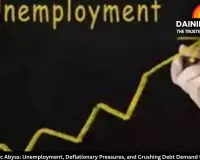Is the World Sleepwalking Back to the Mushroom Cloud Era?
Digital Desk

In a chilling echo of J. Robert Oppenheimer’s haunting words—“Now I am become Death, the destroyer of worlds”—spoken on July 16, 1945, after the first nuclear test, Donald Trump has thrust the specter of atomic escalation back into global headlines.
On October 26, 2025, the US President-elect stunned the world via Truth Social, announcing plans to reverse a 33-year US moratorium on nuclear testing. “We have the most powerful nuclear arsenal, but we stopped testing years ago while others continue.
It’s time to restart immediately,” Trump declared, citing Russia and China’s aggressive advancements. This bombshell, dropped just before his high-stakes meeting with Xi Jinping, raises a terrifying question: Are we on the brink of a new nuclear arms race?
The last US nuclear explosion occurred on September 23, 1992, under the codename “Divider” in Nevada’s desert—a subterranean blast marking America’s 1,054th test. President George H.W. Bush halted further detonations post-Cold War, honoring a fragile détente.
Yet, Nevada’s test site remains on standby, awaiting a single command. Trump’s rationale? Russia’s Vladimir Putin, in military fatigues on state TV, boasted of successfully testing the Burevestnik—a nuclear-powered, unlimited-range cruise missile capable of evading all defenses.
“A unique invention no one else has,” Putin crowed. Days earlier, Russia tested the Poseidon underwater drone, designed to trigger radioactive tsunamis obliterating coastal cities like New York.
Trump’s anxiety is palpable. Official estimates show Russia with ~5,449 warheads, the US at ~5,177 (not Trump’s inflated claim of US dominance), China at 600 but doubling every five years toward 1,000 by 2030. France (290), UK (225), India (180), Pakistan (170), North Korea (50), and unspoken Israel (~90) complete the club.
But numbers mask the madness: Russia’s Burevestnik, powered by a mini-nuclear reactor, flies low, changes paths, and boasts unlimited range—rendering missile shields obsolete. The US abandoned similar “Project Pluto” in the 1960s over meltdown risks and radiation leaks. Russia embraced the danger.
This isn’t mere saber-rattling. The last guardrail the New START treaty capping deployed warheads at 1,550 expires February 2026. Mutual Assured Destruction (MAD), which kept Cold War peace, crumbles as America builds “Golden Dome” defenses and Russia counters with doomsday weapons.
Putin suspended a 2000 plutonium disposal pact, blaming NATO expansion. Trump, furious over Ukraine, canceled Putin talks and imposed fresh sanctions.
Trump’s Tariff-to-Bomb Pivot is Reckless Brinkmanship
From trade tariffs to thermonuclear blasts—Trump’s escalation feels like a dangerous gamble. His Xi meeting in Busan yielded tariff cuts, soybean deals, and rare-earth mineral exports, but nuclear posturing overshadowed diplomacy.
Resuming tests risks unraveling global non-proliferation, emboldening China, India, and Pakistan. The 1996 Comprehensive Test Ban Treaty, though unratified by the US, held moral weight. Breaking it invites chaos.
History screams warnings: Hiroshima and Nagasaki ended WWII but birthed the Cold War race. Stalin tested in 1949; Mao, threatened by US nuclear blackmail in 1954, detonated in 1964.
Today, Putin uses nuclear threats to shield Ukraine aggression. Trump’s “modernization” excuse ignores that simulations replaced live tests decades ago. This isn’t strength it’s fear-driven folly.
The world isn’t ready for mushroom clouds. With US-Russia tensions at boiling point and China rising, Trump’s button-pushing could ignite catastrophe. Diplomacy, not detonation, is the only sane path. As Oppenheimer warned, we’ve known sin. Must we repeat it?





.jpg)

.jpg)

.jpg)
